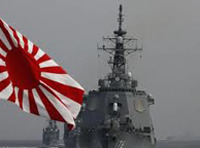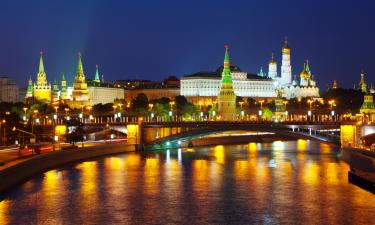Will Russia be able to defend Kuril Islands if Japan attacks?
 Anti-Russian hysteria continues in Japan. On February 7, Japanese revanchists who gathered at the walls of the Russian Embassy in Tokyo demanded that Russia returns four Kuril Islands, and abused the Russian national flag in the process. The police did not intervene in the proceedings, acting as interested spectators.
Anti-Russian hysteria continues in Japan. On February 7, Japanese revanchists who gathered at the walls of the Russian Embassy in Tokyo demanded that Russia returns four Kuril Islands, and abused the Russian national flag in the process. The police did not intervene in the proceedings, acting as interested spectators.
Perhaps the far-right were inspired by Prime Minister Naoto Kan, who spoke on the same day with an official address in which he called the recent visit of Dmitry Medvedev to the Southern Kuriles "inexcusable rudeness".
The next day, February 8, the Russian Embassy received a letter with a bullet and a note from which the Russian diplomats learned that the "northern territories is a Japanese land".
Moscow's position boils down to the fact that four Kuril Islands, whose ownership is disputed by the Japanese, belong to Russia as the successor to the USSR following World War II.
So far the battle for the Southern Kurils is diplomatic. But who knows what would the Japanese do when it becomes clear that their diplomatic efforts are futile? The history has precedents where the ownership of certain territories was disputed at a battlefield.
The latest example of this kind is directly related to Russia - the actions of Georgia in August of 2008 in South Ossetia. Most of the experts did not consider a possibility of an attack. Until the last minute most of them were confident that the little Georgia will not risk fighting with a much stronger Russia. However, as the experience shows, Saakashvili who dreamt of the "return of the historic Georgian territories," was not even afraid of Russian nuclear weapons.
Japan is a much more formidable opponent in all respects. Of course, we can assume that the Japanese leaders, in contrast to Georgia, are much saner and that the economic relationship between Japan and Russia will not allow the conflict flare up. However, economics does not always dominate politics. As evident from history, sometimes the political attitudes may outweigh the economic benefits.
The behavior of the Japanese leadership cannot but cause concern. In 2007, then Prime Minister Shinzo Abe said that it was time to get away from the postwar regime and give the army due respect. In other words, Japan has been steadily reviving the "fighting spirit of the nation" to return to the club of the world powers.
Military spending in Japan is also growing. In 2010 the country ranked fifth in the world in terms of military spending (approximately 44.3 billion dollars annually), outrunning Germany and conceding only to the U.S. (600 billion), China (81.4 billion dollars), the UK (48.8 billion dollars) and France (45 billion dollars). Most likely, considering that the latter are significantly reducing their military budgets, in 2011 Japan could get to the third place in the world and would compete with China for the second. Russia is far behind Japan in terms of these indicators.
In this regard, in recent years the Japanese have been actively building up their offensive potential. It now has an entire set of attributes of superpower, including military preparedness. For example, Japan has aircraft carriers, a modern missile defense system, and powerful air forces of "self-defense".
Overall, the Japanese self-defense forces, not counting civil employees, amount to 240,000 people and are among the most powerful in the region. This is substantially contributed by regular updates of military equipment. A specific role is given to the Navy that includes over 250 combat ships, support ships and boats.
In addition, the Navy has 40 destroyers, of which eight are guided missile defense destroyers capable of hitting targets at long range. The Japanese naval forces continue to grow, including amphibious.
Among them there are four (according to other reports, five) "flagship" ships that are helicopter carriers. They perform both the role of aircraft carriers and amphibious units. Moreover, helicopter destroyer of the Hyuga class introduced in 2009, according to the general opinion of military experts, is a light aircraft carrier, which can be rapidly converted to receive military aircraft.
It was called a destroyer only to avoid postwar restrictions on the ability to have ships of this class. In the coming years two more ships of this class with a displacement of 19,500 tons and capable of accommodating every 14 helicopters, four thousand soldiers and 50 trucks will be introduced.
Currently there are five Japanese small and medium landing ships, as well as at least eight landing crafts, with which they can land troops in heavy weather and natural conditions. The landing crafts alone can land up to 36 armored vehicles, or more than 4.2 thousand marines at a time. In addition, the Japanese leaders do not rule out future significant increase in the number of amphibious ships and boats.
Furthermore, government officials declare their intention to revive full-fledged Marines, creating "mobile assault units," designed to capture the coastal strip of the probable enemy.
That is, Japan has been actively building up its strike group designed to conduct amphibious operations. Is Russia ready for the Japanese that once had lost all hope of returning "native Japanese territories," to take action?
Konstantin Sivkov, senior vice president of the Academy of Geopolitical Issues, answered this question for Pravda.ru.
"Of course, when we try to imagine a scenario of conflict with Japan, we should take into account the fact that it is not limited to amphibious operation in the Southern Kuril Islands," the expert believes. "Japanese revenge-seekers who are raising their head increasingly more must understand that in case of military adventurism on their part they will have to deal with Russia on the vast theater of operations, from Vladivostok to the Kuril chain, and possibly up to Kamchatka. They surpass Russia both at sea and in the air at this point. Although on our side we have strategic aircrafts unavailable in Japan. Thus, our missiles can be guaranteed to hit targets within a radius of 1500-2000 kilometers.
With regard to nuclear weapons, in a conventional conflict, without the use of weapons of mass destruction, we simply will not use it, and we do not hope that it can stop the aggressor.
Until recently there was a rather strong Russian unit in the conflict zone, including an artillery division, designed precisely to reflect a probable enemy assault. However, in 1990, our Kuril group significantly deteriorated in the general context of weakening of Russian defenses. In particular, a significant portion of the park was comprised of obsolete armored vehicles T-55. Or there is something else - while the Japanese are increasing their military preparedness, we are only just beginning to wonder out loud: "Should we send S-300 to the Kuriles? It says a lot.
In case of an attack of a potential enemy, our Kurile unit, including the southern islands, is guaranteed to hold out for a day or two. Maximum - three or four days. During this time we must ensure the delivery of reinforcement, otherwise the outcome of the likely conflict may not be very pleasant.
It is important that the transport infrastructure connecting the archipelago with the mainland leaves much to be desired. In recent years, observing the Japanese to increase their offensive force, we also expressed some interest in the defense of the Kuril Islands and started building new and reconstruct old airfields.
In the foreseeable future, the Japanese are unlikely to hold military adventure. However, this cannot be guaranteed further on, especially if we are at war with some third country and are not able to pay due attention to the Far East direction".
There has been a similar precedent in history. In 1855, using the fact that Russia was involved in the Crimean War, the Japanese pushed for a favorable agreement on the South Kuriles. Not wanting to conflict with Japan, Russia gave them four islands, which the Japanese are not willing to forget.
At one time the notorious Bismarck spoke of possible opponents: "I'm not interested in their intentions, I'm interested in their capabilities." The capabilities of the Japanese are getting larger.
Sergei Balmasov
Pravda.Ru
Subscribe to Pravda.Ru Telegram channel, Facebook, RSS!



